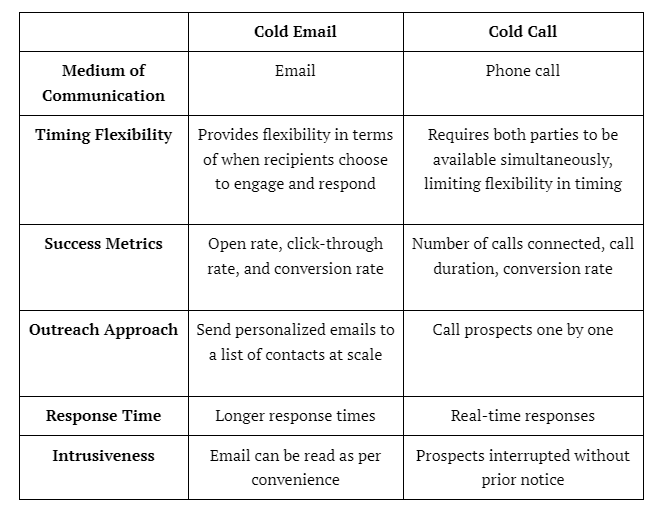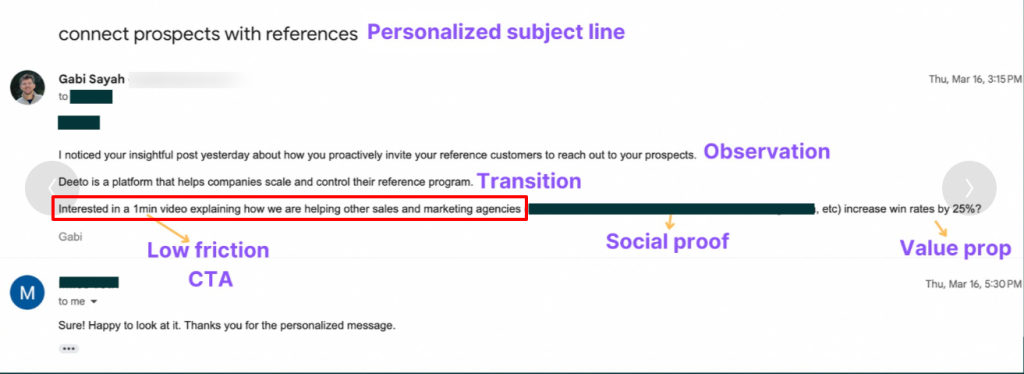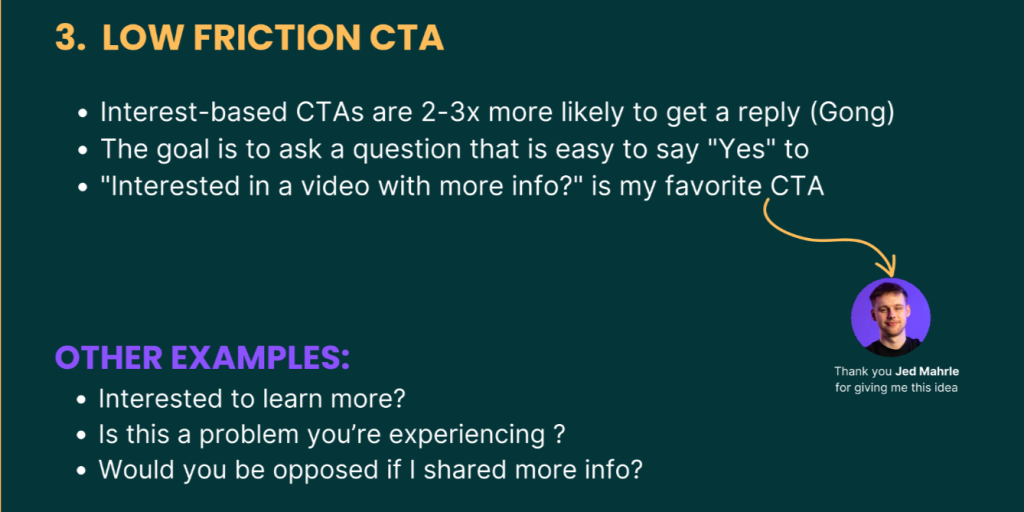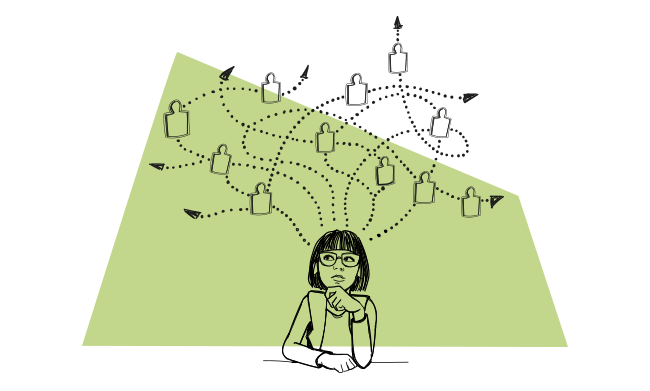Cold calling is one of the oldest techniques for generating new prospects. But does it truly capture the attention of C-suite executives if they are your prospects?
Probably not!
Cold calls are a thing of the past. CXOs aren’t going to be in for a 10-minute product monologue.
This is why you need to shift towards Cold Calling 2.0 – Cold Emailing.
In this article, we’ll talk about how you can set up a perfect cold email campaign for your business and please CXOs out of their minds.
Let’s get into it.
What is Cold Calling?
In the simplest terms, cold calling involves reaching out to potential customers by initiating a phone call with them in an attempt to get business. It should not be confused with a scheduled appointment, where the prospect is aware that a meeting is planned. In a cold call, the recipient is not anticipating your call.
When considering response rates, cold calling doesn’t show significant effectiveness, as it has a conversion rate of just around 2%.
Plus, if C-suite executives are your prospects, reaching out to them through cold calling is no easy feat and isn’t the most effective approach either.
Cold Email vs Cold Call: What Sets Them Apart?
Both cold calling and emailing are ways to reach out to potential customers that you haven’t interacted with before.
However, there are several key differences between the two, as below:

Why is Cold Email the New Cold Call?
Today, traditional cold calling has proven ineffective in establishing connections with decision-makers, especially the powerful and busy C-suite.
Attempting to engage CEOs through unsolicited calls often results in a low success rate due to their demanding schedules and aversion to lengthy verbal pitches.
This is where “Cold Calling 2.0” comes into play —a paradigm shift where cold emailing takes center stage as the modern substitute for traditional cold calling.
With response rates as high as 8.5%, cold emailing has become the norm to get in touch with top-level executives.
Challenges One Faces While Emailing C-level Executives
Securing the attention and response of a C-suite exec through email is no simple task. The likelihood of your emails being responded to or even opened is often slim, given their busy schedule and high expectations.
Here are some reasons:
- Getting Unnoticed: C-level execs are drowning in emails daily, so chances are your message might slip through the cracks. Make sure your email is well-crafted, relevant, and stands out from a lot of other emails they receive every day.
- Poor Language & Tone: You may be using language that sounds disrespectful and unprofessional. Opt for a formal and polite approach, but don’t sound like a textbook, too – not everyone’s a fan of that, either.
- Trust-building Issue: C-suite execs can sense something is wrong from miles away. They get a lot of random emails every day, and they have a way to distinguish between trustworthy and dubious ones. This makes it important to introduce yourself and your business or company in a trustworthy and professional manner.
- No Replies to Lengthy Emails: Decision makers don’t have enough time to scroll through long emails. If your email fails to capture their attention early, your email campaigns become a futile investment of time and money. Keep your emails short and to the point.
11 Best Practices for Cold Emailing to C-Suite Executives / CEOs / Founders
1. Create a Separate Domain for Sending out Emails and Protect your Domain’s Sender Reputation
An effective copy that provides value indeed safeguards your domain. However, given the saturation of target markets these days, one wrong move can lead prospects to view your emails as spam, not just by filters, but by people. That could hurt your primary domain’s sender reputation.
So, it is best that you set up new mailboxes for your sales representatives under different domain names. Setting up a separate mailbox for outbound helps you stay organized, have better access control, and make it easier to track performance.
2. Need to create strong email subject lines
The effectiveness of your email outreach to business leaders largely depends on the first thing they see: the subject line.
In an inbox filled with hundreds of emails every day, your subject line needs to stand out, capture attention, and compel CXOs to open your message.
Here are key strategies for creating strong subject lines:
1. Taping Pain Points
To grab the attention of busy executives, pinpoint their pain points. After all, that is what you need to solve for them.
Craft a subject line that addresses a specific challenge they might be facing.
One unique way to achieve even better results is to use a question that challenges the recipient’s expectations like “Do you still think a 2% conversion rate is good?”
In doing so, you demonstrate your ability to achieve higher conversion rates for them, compelling them to open your email.
2. Creating a Sense of Urgency
Subject lines that create a sense of urgency increase the open rate by an average of 22%. You should incorporate words that convey urgency and importance in your subject lines.
Example: Next week only – watch me {do something} live!
The email below sent by Jimmy Kim of Sendlane had a 15% click through rate as it had a sense of urgency in the subject line.

When SumoMe revealed their 10 of the best performing subject lines, four of them were based on urgency and invoked FOMO (fear of missing out).

3. Subject Line Personalization
Personalized subject lines increase open rates by almost 50%. You need to demonstrate genuine interest by personalizing subject lines.
Include their name, company, or recent achievements for a personal touch.
Example: “Elevate [Executive’s Company’s Name]’s Strategy with [Your Solution]”
4. Keeping it Concise
A short and crisp subject line works wonders. Plus, many email clients display a limited number of characters. So you need to make sure that the important stuff isn’t cut off.
Aim for about 6-10 words or 50 characters. Anything more than that is usually considered too much.
Content Marketing Up saw open rates as high as 22% with shorter email subject lines.

5. Avoiding Spam Triggers
Did you know that 69% of email recipients report an email as spam on the basis of the subject line alone?

Moreover, email clients have smart spam filters that can catch trigger words and symbols like “Completely FREE,” “$,” and “Earn 10$ With a 101% Guarantee”, and will 101% force your emails straight to SPAM.
Even if spam filters don’t detect this, execs aren’t going to open such emails in the first place.
6. Test and Iterate Subject Lines
If you’re a smart marketer, you certainly know the power of A/B testing. Create different versions of subject lines and select the best one based on an A/B test by measuring KPIs like open rates, response rates, etc.
Keep in mind that an A/B test does not generalize findings. Its outcomes vary across industries and businesses.
MailerLite did an A/B test and found that in a particular campaign, shorter subject lines had a 100% open rate while longer ones only achieved a 71.43% open rate.

3. Send the Email First Thing in the Morning
Laura Vanderkam, a time-management expert, polled 20 C-suite executives and found out that 90% of them wake up before 6 AM.
The same study also found that top-level executives make sure to check their emails as part of their morning routine. So your best bet would be to send them your emails between 6 AM to 9 AM.
During the morning, recipients typically have minds free from the distractions of the workday or post-work responsibilities. This increases the likelihood of them not only opening your email but also responding to it.
4. Always Check Open Rates and Response Rates
The two most important metrics or KPIs of a cold email campaign are open rates and response rates.
Low open rates indicate something is wrong with your subject lines or send timings, while low response rates suggest a need for improvement in crafting compelling email content that captures your prospects’ interest.
Increment in these metrics is a perfect indicator of your cold email campaign’s success.
5. Cut Out Pleasantries
Top-level executives are too swamped for pleasantries like “greetings” or “hope you’re doing well.” If your cold email kicks off with these, chances are they’ll hit delete without a second glance.
Dive right into addressing their pain points from the get-go and smoothly transition into showcasing how you can provide solutions.
Time is of the essence here, so make every word count.
See how Brad Morris from Trackland sent a cold email to Mike Gallardo at Deel. There isn’t even any greetings; just the receiver’s name and straight to the point.

Mike even went to LinkedIn to say why he liked the cold email. The first line being a great segue was one the reasons why he liked the email.

6. Keep Your Email Length to 150 Words
The notoriously ill-focused goldfish has an attention span of 9 seconds. What about humans? It’s just 8.25 seconds.
And you’d be wise to attribute an even lower attention span to a top-level executive, given their busy schedule.
The optimal length of a cold outreach email should lie somewhere between 50-125 words, translating to 5-15 lines of text. A study by Boomerang shows that emails that were this long had the highest response rates, over 50%.
Learning: When in doubt, try to keep your emails shorter and under 200 words, and you’re good to go.
In the same example as above, Mike says he also liked the email because it was just 58 words.

7. Improve Response Rates
While open rate is a good metric to track, your response rate will decide your business’s bottom line, as high open rates correlate with increased conversion rates.
Steli Efti of Close CRM says a response rate below 5% indicates something is wrong with your approach; you’re fairly on the right track if you fall in the 10% range, and you’ve got some magic going on if you’re anywhere between 10%-30%.
The average cold email response rate is just 8.5%.
However, you can work on increasing this.
Here’s how some factors increase your response rates:
- Personalized subject lines – By almost 50%
- Personalized message body – By 32.7%
- One follow-up email: Up to 13%
8. Personalized Introductions
Any email marketer understands the importance of personalization in email campaigns.
Beware if you’re thinking about just dropping names and titles – that won’t do the trick.
It’s about really knowing your recipient and doing some homework. This way, they sense you’ve got the lowdown on them and you’re not just here to waste their time.
Arnaud Belinga, co-founder of Breakcold, uses a smart way to hyper-personalize cold email introductions. He aggregates the latest social media activity of his recipients and leverages it to personalize cold email opening lines.
He even makes sure to like and comment on the posts beforehand so that the recipient remembers him.
Here’s a cold email that Laura Nelson from Rift sent to Matt Firestone at Noble.

Matt shared on LinkedIn that one of the reasons he appreciated the email was its effective trigger at the beginning. Laura recognized his comment on a sales-related post relevant to Rift’s value proposition—a great example of a personalized introduction.

9. Combine Industrial Insight with Value
Make sure to back up your claims with industry know-how or share success stories of how clients have gained from your solution. It signals you’re in sync with the industry’s ins and outs.
Adding these insights not only boosts your credibility but also builds the trust we talked about earlier.
Again, Brad Morris does this by providing industry insights in his cold email to Mike Gallardo.

10. Sign Off with CTA + Simple Signature
The purpose of your email is for the CXO to take action. So slide in a soft call-to-action that sounds like you respect the CXO’s time and aren’t forcing them to take action.
According to Devin Reed, ex-Head of Content Strategy at Gong, the most effective cold email CTAs inquire about the recipient’s interest in the product or offer rather than proposing or requesting a specific meeting date.

Gabi Sayah at Deeto shares how you can increase your cold email reply rates with a soft CTA like the one in the email below.

He also talks about his favorite CTAs on LinkedIn.

Ensure your email concludes with a clean and professional signature, including your name, job title, LinkedIn profile, other relevant social media links, and contact details.
11. Follow-ups, Follow-ups, Follow-ups
Follow-ups are a reminder for your prospects that you attempted to reach them, but they might have been too busy to open your email or respond to it.
Our findings reveal a 9% reply rate for campaigns with 1-3 emails in a sequence and a significantly higher, 27% for those with 4-7 emails.

Based on this, it is recommended to send more follow-ups for better results.
3 Personalized Cold Email Templates to Get Your Lead’s Attention
1. To Intrigue a CXO About Your Company
Subject: [Prospect’s name], You have to try [insert name of solution/product]
Hi [First Name],
Did you know that [add an achievement related to your business]?
We found it hard to believe, too, when we first heard that!
But it is possible. We here at [your company], have crafted the perfect solution to [explain the problem].
If this is something that interests you, let me know.
My team and I will be more than happy to set up a demo call to guide you through the process.
Hope you have a great day!
Best,
[Your Name]
2. To Schedule a Call Your Prospect Won’t Say No to
Subject: [Prospect’s name], I only need 10 minutes!
Hi [First Name],
I’m [Your Name], and I work as a [Job Title] at [XYZ].
I value your time and won’t take much of it.
[Your company] specializes in [your product] and has over [X,000 users] to date.
We recently helped our client [your client] almost triple their [KPI]. Your company could achieve that too.
Let’s schedule a quick 10-minute call so I can walk you through our product.
When works best for you?
Best,
[Your Name]
3. To Establish Value
Subject: What will [prospect’s company] X [Your company] look like?
Hi [First Name],
I saw you recently shared a whitepaper about XYZ. I’ve worked with similar companies in [Y industry], and I thought I’d reach out.
[Prospect’s Company] looks like a great fit for [Your Company], and I’d love to know what your goals are for this year.
We help companies like yours grow with the following:
A solution/result
B solution/result
C solution/result
If you’d like to learn how [Your Company] can help you reach [X goals], feel free to book a meeting on my calendar here: [Meeting Link]
Thanks,
[Your Name]
Final Thoughts
Cold emailing stands out as a powerful tool for forging connections, closing deals, and nurturing professional relationships with C-suite executives.
As an email marketer, there are certain challenges you’re going to face when trying to reach out to CXOs, and these challenges will always prevail unless you tweak your strategy a bit.
With this guide, you can fine-tune your approach to enhance the efficiency of your cold email campaign, ensuring a more impactful and successful engagement with C-suite decision-makers.
—————-
Author’s Bio:
Dhruv, a specialized SEO consultant, is an expert in boosting visibility for SaaS MarTech. In his free time, he enjoys writing about marketing, SaaS, and customer experience. He is also passionate about sharing tried and tested, as well as easy-to-implement, SaaS SEO and marketing insights from Clickass.
Headshot:

LinkedIn Profile: https://www.linkedin.com/in/thedvmehta/

